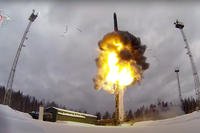The argument was settled 150 years ago -- or so it seemed. In the 1850's, aviation pioneer Sir George Cayley proved that flying machines didn't have to -- in fact, shouldn't -- flap their wings to stay in the air.
Now, some government-funded researchers are re-opening the debate. University of Missouri-Rolla engineers are working on the "world's first flapping-wing, unmanned aircraft driven entirely by solar power," Wired News tells us.
The aircraft is being designed to flap its wings not with conventional mechanical parts, but with an exotic material that can deform in an electric field like an artificial muscle. The craft is made to fly at altitudes of 30,000 to 40,000 feet.
With a wingspan of about 3 meters and thin membrane-like wings, the bird-like craft would be able to flap its wings once every one to 10 seconds, and have the flight profile of an eagle. K.M. Isaac, professor of mechanical and aerospace engineering at UMR, who is helping to develop the aircraft for NASA, says that using a renewable power source could help the aircraft stay airborne for weeks.
Isaac's work is being supported by the NASA Institute for Advanced Concepts -- the space agency's "sci-fi" research arm.








